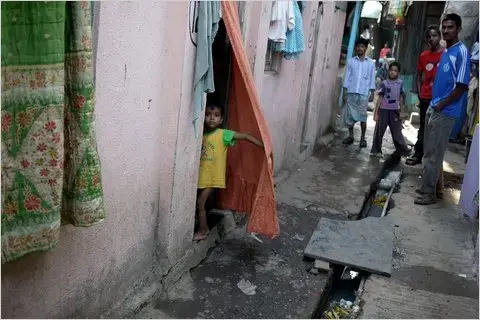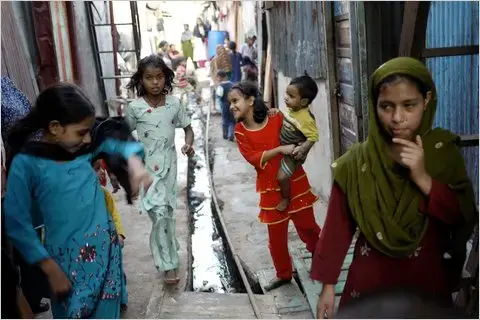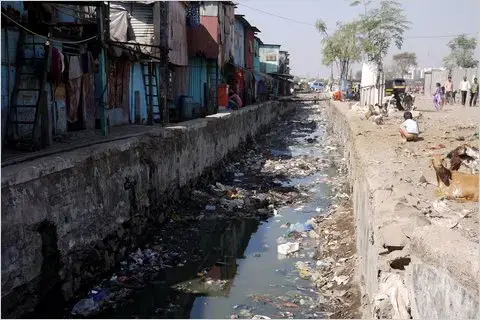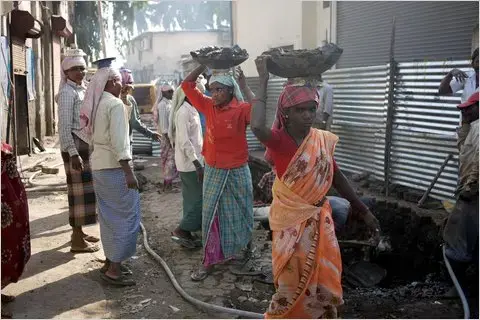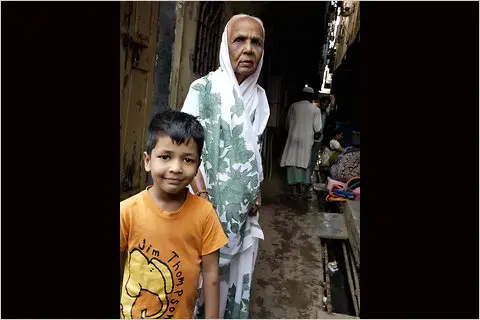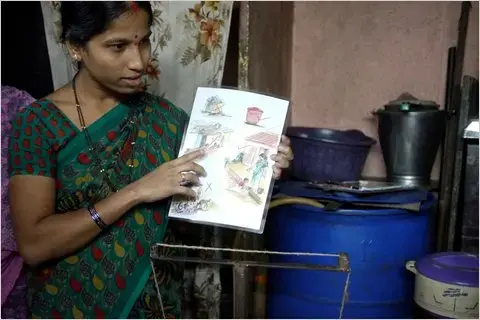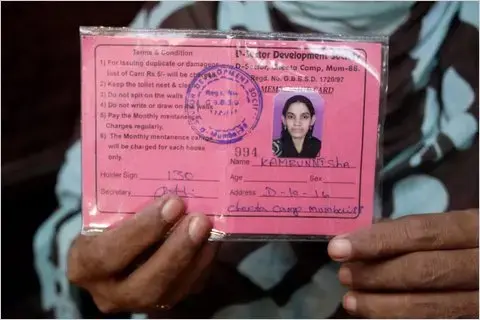A resident of Cheeta Camp holds up her toilet facility membership card.
It was while stepping over the channels of ochre fluid that run between the raggedly cascading apartment blocks that make up the Mumbai slum known as Cheeta Camp that James Potter discovered a real-life version of what could be a scene out of a magical realist novel by Salman Rushdie: a toilet facility that gets built and then torn down again, always on the verge of being finished, but never usable.
"Five or six people circled around to tell me the tale of the perpetually about-to-open toilet. Apparently, for the last 15 years or so, the toilet had been built, demolished and rebuilt three times," said Mr. Potter, a Hindi-speaking student who is pursuing his master's degree in public health at Harvard.
Each time, local politicians claimed that the lavatory facility would open "after the elections," but that never happened. Instead, the residents told Mr. Potter, the government workers would just tear it down and start to build a new one next time the elections rolled around. "The neighbors didn't have any expectation that the current structure would be opened any time soon," said Mr. Potter.
Mr. Potter was one of a dozen students from the Harvard School of Public Health who traveled to Mumbai in January to research life in the city's slums. The mishmash of variables in high density city life make urban public health one of the most pressing and yet least understood aspects of global health. This is especially true in Mumbai, with over half the city's population of more than 12 million living in slums.
Mr. Potter and his colleagues decided to create a map of Cheeta Camp's toilets (the interactive map can be found here). That meant two weeks tromping around the slum, figuring out where the toilets were located, who had put them up, how they functioned, and if they were even operational.
The students saw toilets as a way to delve into the inner workings of the community, to see what worked and what did not. Of course, toilets are more than just a proxy. They are about as fundamental as you can get.
"Poor sanitation is one of the most important underlying causes in the country's pervasive malnutrition," said Dr. Richard Cash of the Harvard School of Public Health, who led the student trip. Dr. Cash has plenty of experience with the effect of poor sanitation on health; his work on cholera in Bangladesh in 1960s led to the creation of oral rehydration therapy, an inexpensive and simple way to treat diarrhea that has saved millions of lives.
Cheeta Camp is an Indian oddity — a planned slum. It was formed in northeastern Mumbai when an impoverished community was moved to make way for a government atomic research station. The displaced residents were given plots of land on which to settle, but no provision was made for basic infrastructure like sewers.
So toilets were built ad hoc. The first thing the students found was that nobody really knew how many toilets were in the camp: the local authorities said one thing, local nongovernmental organizations another. So the students counted and mapped. They found 46 toilet facilities, containing 701 toilets, to serve Cheetah Camp's 117,000-person population. Of these 46 facilities, 38 were functional. That means roughly one toilet per 170 people.
While a recent movement has sprung up over getting the government to provide more free public toilets, in Cheeta Camp, the Harvard students found that most people preferred the pay toilets. Unlike the free public toilets, the pay ones, which were generally provided by a nongovernmental organization, had water, electric light and were kept cleaner than government-run facilities — well worth their 1 or 2 rupee (2 or 3 U.S. cents) cost.
In the old days, women would avoid the public toilets entirely, said Aminabi Mohd Abdul Farah, an 80-year-old grandmother of six who has been at Cheeta Camp since 1976. "The ladies would go in the jungle, they were too scared to go to the toilet," which was little more than a hut. "It was unsafe. People were scared."
The new facilities, built in her neighborhood about five years ago, are a huge improvement, she said. "There is water, light, everything so we don't have any problem. Why get scared?"
The fact that poor people are willing to pay for cleaner, safer toilets belies the typical portrait of the poor as helpless victims. The clean pay toilets seem to have made a difference: "Now we don't have to spend so much on doctors. Previously we had to struggle a lot, but now are happier," said Kanis Sayyed Hashim, a 45-year-old mother who has lived in the slum for 26 years and said her children get sick less now that they use the pay toilets.
Pay or no, small children do not generally use any of the toilet facilities, finding them too big, messy and intimidating. Instead, they generally do their business in the open, directly into sewers or near drains. Some slums have toilet facilities built for small children, but there are none in Cheeta Camp yet.
The lack of basic services in Cheeta Camp is typical of Indian slums. Despite India's economic boom, most government services created in recent years help the "better-off population of city dwellers," according to a report in the journal Economic and Political Weekly on sanitation problems in the slums. Corruption and lack of accountability for officials are pervasive problems.
Governments are often loath to even officially acknowledge slum dwellers, because it would imply they should then receive basic infrastructure, said Dr. Patil-Deshmukh, executive director of Partners for Urban Knowledge, Action and Research, a Mumbai urban research and advocacy organization.
By mapping the locations and functionality of the toilets, the students were echoing a process that had been used by slum dwellers organizations in India to force government to act. The act of naming streets, counting citizens and mapping facilities turns information into an advocacy tool.
The students have given the map to local nongovernmental organizations and the medical director of Cheeta Camp's health center, "who seemed pleased to have a better map of the camp and thought the toilet information would be helpful," said Rosemary Wyber, one of the Harvard team. When the map is finalized, they will present it to the Municipal Corporation of Greater Mumbai, the city's governing body.
"The first thing we heard when we arrived was that there wasn't enough space to build new toilets," said Jennifer Weaver, another of the Harvard students. Once their map was finished, she said, they "could that show that of 46 toilet blocs, eight did not work. So why not fix those toilets?"



